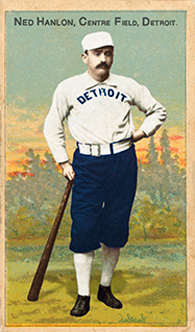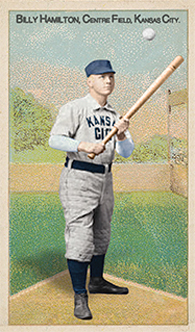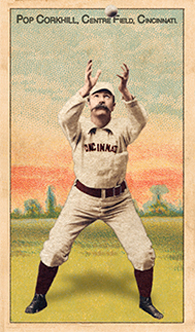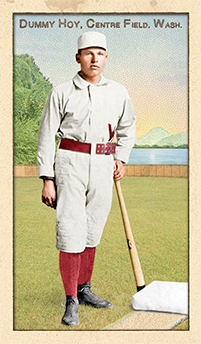- Series: Beginnings: 1880's
- City: Detroit
- Team: Wolverines
- League: National League
- Hall: National Baseball Hall of Fame
Permanent Outtake: Alternate batting pose.
After finding an alternate pose with better detail, I retired this version and made a new one. You can find the new card here.
- Series: Beginnings: 1880's
- City: Kansas City
- Team: Cowboys
- League: American Association
- Hall: National Baseball Hall of Fame
Permanent Outtake: Alternate batting pose.
After finding an alternate pose with better detail, I retired this version and made a new one. You can find the new card here.
- Series: Beginnings: 1880's
- City: Cincinnati
- Team: Red Stockings (AA)
- League: American Association
Undecided: I love this image of Pop, but the quality is not great. I am still not sure if I should wrestle with it again or retire the card permanently.
- Series: Beginnings: 1880's
- City: Washington, D.C.
- Team: Nationals
- League: National League
William Ellsworth Hoy (1862-1961) was a renowned outfielder for the Cincinnati Reds & other clubs over a 15 year career. Hoy was rendered deaf by a childhood illness. He was not the 1st deaf player in the majors, but he was the most accomplished, using his speed and small stature (5’4”) to generate walks and steals. Hoy retired in 1902 holding the career record for outfield chances.
- Hoy’s record three outfield assists to the plate in one game were all to his catcher Connie Mack
- At his death in 1961 he was the longest lived major league player at 99 years of age
- Hoy's uniform color on this card was changed in June, 2017 from blue to red to reflect recent reliable research by Craig Brown & friends at Threads of Our Game. Nine cards were previously released featuring a blue uniform.
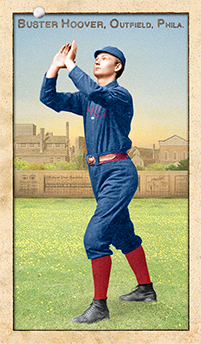
- Series: Beginnings: 1880's
- City: Philadelphia
- Team: Quakers
- League: National League
William James Hoover (1863-1924) was a prime example of players from the beginning of baseball who could shine at the amateur or minor league level and fail when up against the true elites of the game. In Buster’s case, the exception (the Union Association of 1884) proves the rule. That is where Hoover began in the “majors” but was really playing against minor-league caliber opponents. He wowed, hitting .364 (2nd in the league), third in OBP and slugging. Then that quixotic misadventure ended and the players had to find real homes. Buster’s was still in Philadelphia with Harry Wright’s Quakers where he hit .190. After years mostly in the minors (where he often excelled, averaging .306 over 11 seasons) he got a shot with the Orioles and hit .217. Finally, the Cincinnati Reds gave him a try in 1892: 14 games, .176. Hoover finished up hitting .305 for the Troy Washerwomen in 1894.
- Bill James has thoroughly analyzed the quality of the Union Association and found that it, like the anonymous Wisconsin dairy, could have embraced the motto: “Our Best Is None Too Good”
- Hoover’s uniform color on this card was changed in June, 2017 from black to blue/red to reflect recent reliable research by Craig Brown & friends at Threads of Our Game. Five cards were previously released featuring a black uniform.
